
<<< back
 |
eDESADV; V 2.0 <<< back |
The eDESADV recommendation is based on the framework of EANCOM® 2002, the EDI standard from GS1 within the GS1 system. The aim of the recommendation in hand is to offer documentation describing the exchange of delivery data between business partners in Europe.
The basis of this elaboration is the international standard EANCOM® 2002. The message type DESADV EAN007 is used to transmit relevant data. Please be aware, however, that this documentation does not replace the complete specifications in the original chapters, or other relevant instructions within the EANCOM® 2002 documentation. Instead, it deals with the description of segments, data elements and codes to be used for a specific task.
So far, the following countries have contributed to this recommendation:
Austria
Belgium
Denmark
France
Germany
Ireland
Netherlands
Poland
Spain
Sweden
Switzerland
United Kingdom
All relevant information content i.e. business terms of each country has been created. The total of all of the business terms used by those countries compromise the set of business terms used in the European profile.
This guideline provides various options for navigation. We provide two profiles: When selecting the core profile, only the information used in most business contexts is displayed. When selecting the European (all) profile also the information that only is used in specific business contexts is displayed. Generally, all information is provided in English.
Further information regarding the use of EANCOM®/EDIFACT can be obtained from Appendix 1 (chapter 5) of Part 1 of the EANCOM®-manual.
The eDESADV message implementation guideline is divided into four sections:
Section 1, "Alphabetic list of Business Terms"
In this section the
Business Terms which are used in the selected profile are listed in alphabetic
order. Within this Business Term list is a harmonised definition of each
Business Term and, if applicable, additional comments and/or dependency notes
are provided.
Within the table, the Status of each Business Term in each profile is provided. This status information is linked to the relevant segment in the Segments Layout. The following abbreviations are used for status indication:
R = Required
O = Optional
D = Depending
N = Not Used
By clicking on the 'core' and 'all' buttons, the profiles can be selected.
Section 2, "Message Structure Chart"
The message structure chart is
a list of all segments used, in the same sequence as they are defined in the
EANCOM® message. In general, for each piece of information, a single
segment is provided. Exceptions may arise when the occurrence of a segment is
limited and can contain alternative information (e.g., segment BGM). By clicking on the 'core' and 'all' buttons, the profiles can be selected.
Section 3, "Branching Diagram"
The branching diagram is a
hierarchical graphic depiction of all segments used, in the same sequence as
they are defined in the EANCOM® message. However, every segment is
shown only once. By clicking on the 'core' and 'all' buttons, the profiles can be selected.
Section 4, "Segments Layout"
The segments layout provides an
illustration that has been chosen to match the Business Terms with the elements
from the EANCOM® syntax.
In the right-hand column "description" the Business Term, the definition and the comments /dependency notes are provided. The Business Term is linked to the Business Term List. The "Legend" is linked to this chapter of the introduction. Further information on applying EANCOM®/EDIFACT messages, e.g. status indicators, conventions, field length etc. can be obtained from Appendix 1 (chapter 5) of Part 1 of the EANCOM®-manual.
By clicking on the 'core' and 'all' buttons, the profiles can be selected, if the relevant segment is part of the chosen profile.
In general, code names are represented in red; these must be understood as being restricted. If codes are given as examples, they are represented in blue (e.g., measurement units). In this case, all codes contained in the relevant code list can be used. By clicking on the codes or the data element/code list number, the codes which are used in this guideline are displayed.
Message structure
The eDESADV message is divided into the following sections:
1. Heading section
Specification of parties, dates, references,
etc.;
2. Detail section consignment
Specification of information
about the total consignment;
3. Detail section despatch units
Specification of information
on despatch units that contain another layer of despatch units;
4. Detail section despatch units / articles
Specification of
information on despatch units and the articles contained.
This means that part of the message is included 3 times in the guide, each with different usage and recommendations, whereas in the “full” EANCOM® DESADV message these uses are all part of the same, unique occurrence of this section.
5. Summary section
The summary section contains the number of line items in the document.
A basic element of EANCOM® is the GS1 System. Each trade item, "item" being defined in the widest possible sense, is uniquely identified by a Global Trade Item Number (GTIN). This number is part of the common vocabulary adopted by the partners who are exchanging standard messages.
The format and use of a GTIN is explained in the GS1 General Specifications.
The identification of the trading partners is a critical issue when using Electronic Data Interchange. It is even more important to identify locations precisely and unambiguously with EDI than with traditional paper documents.
The identification of parties and locations within EDI messages is the primary application for the Global Location Number (GLN). Within EANCOM® a message and a number of segments exist for the purpose of identifying parties.
The GLN is explained in detail in the GS1 General Specifications.
Data which do not vary between transactions such as terms of delivery, shipping, and payment agreements, prices, clear text for Global Location Number (GLN) and Global Trade Item Number (GTIN) should be part of the underlying business contract and accessible by the respective party's business application, for use as appropriate. Each trade item must be numbered (and bar-coded) with its Global Trade Item Number, GTIN. In some cases, however, additional information such as article text may be provided, if the master data is not available - e.g. where a central payment service provider is involved.
Message Number assigned by document sender. The order number must be unique by document. It is recommended that the length of document number be restricted to a maximum of 17 characters.
The effective use of EANCOM® depends on the use of referencing to reduce the quantity of data required to be transmitted in any message. Referencing provides the opportunity to link messages with multiple pieces of external information which may or may not have been transmitted using EDI. The RFF segment allows references to other documents to be transmitted without a need to transmit the actual documents.
Within EANCOM® messages several references exist which can be used to link the information exchanged between the trading partners with the physical movement of goods or data.
The only method available within EANCOM® to uniquely identify a previous EANCOM® message is to put the message number (generated in DE 1004 of the BGM segment of the original message) in data element 1154 of the RFF segment. Should it be required to identify an individual line (identified by Line Item Number data element 1082 in the LIN segment of the original message), then this should be put in data element 1156 alongside the message number in data element 1154 of the RFF segment.
This section provides some general recommendations for the Despatch Advice Guideline. These recommendations are made within the framework of EANCOM® 2002, in particular Part 1, which gives additional advice on the use of EANCOM® messages.
Important:
The “full” EANCOM® DESADV message provides 4 different approaches (called “Options”) for the DESADV message, which reflect an increasing degree of complexity and completeness.
- Options 1 and 2 consider the shipment as a whole, making abstraction of its structure (only a “dummy” CPS segment is used: CPS+1').
Option 1 is the most basic situation, providing only product identification (GTINs).
Option 2 adds unique identification (SSCCs) for all cartons/cases in the shipment. I.e. only the smallest individually identified transport items (Trade Units) are considered, even if they are contained within larger units also marked with an SSCC.
- In Options 3 and 4 the (hierarchical) structure of the shipment is added.
In Option 3 unique identification (with SSCCs) is only provided for Logistic Units.
Option 4 additionally identifies Trade Units (cartons and cases) with SSCCs.
The Despatch Advice Guideline assumes the use of the SSCC as an essential key to the efficient use of the DESADV message. The aim is to provide as complete a description of every shipment as possible, depending on the available data. The most frequent packaging scenarios are discussed in detail in Section 4.3.
This paragraph describes how to apply the NAD segments in some commonly used business scenarios. As the business parties involved can have a different function depending on the scenario, the way they are described in the message will change accordingly. The roles the trading partners can play, and their corresponding EANCOM® code value, are as follows:
- Supplier (mostly a manufacturer): “SU”;
- Buyer (often a retailer): “BY”;
- Delivery Party (where the goods listed in the message will be delivered): “DP”;
- Ultimate Consignee (where the goods are supposed to finally end up; this is not necessarily the receiver of the DESADV message): “UC”;
- Despatch Party (where the carrier takes over the goods, if the seller doesn’t organize the shipment): “PW”.
Note that in general still other parties (e.g. logistic service providers) will be involved in the final scenario.
In this scenario one Delivery Party (location) is identified apart from Buyer and Supplier.
This is as plain as a Despatch Advice gets, for in general Buyers will request the merchandise to be delivered on a specific location (a warehouse) which is not the the company’s Head Quarters.
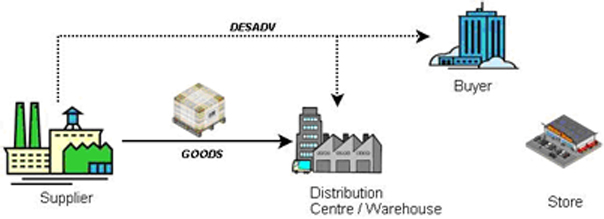
Example of the NAD Segments used with the relevant Qualifiers:
NAD+BY+<GLN-BUYER>::9' Buyer identified by GLN <GLN-BUYER> NAD+SU+<GLN-SUPPLIER>::9' Supplier identified by GLN <GLN-SUPPLIER> NAD+DP+<GLN-DC>::9' Delivery Party identified by GLN <GLN-DC>
In a ‘Cross docking’ scenario the Supplier ships to a Distribution Centre, where the shipment is rearranged or/and combined with other products, next shipped on to other destinations (e.g. stores).
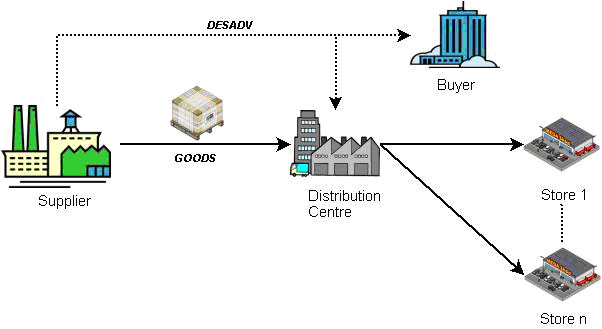
Example of the NAD Segments used with the relevant Qualifiers:
NAD+BY+<GLN-BUYER>::9' Buyer identified by GLN <GLN-BUYER> NAD+SU+<GLN-SUPPLIER>::9' Supplier identified by GLN <GLN-SUPPLIER> NAD+DP+<GLN-DC>::9' Delivery Party identified by GLN <GLN-DC> NAD+UC+<GLN-STORE>::9' Ultimate Consignee identified by GLN <GLN-STORE>
This situation is identical to 4.1.1. (Direct to DC).
Whether the goods are to be delivered at a Distribution Centre or directly at a store, doesn’t make any difference in the message.
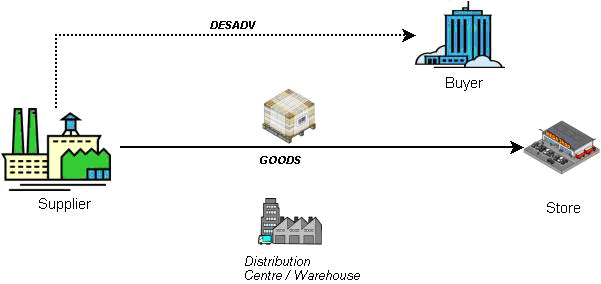
Example of the NAD Segments used with the relevant Qualifiers:
NAD+BY+<GLN-BUYER>::9' Buyer identified by GLN <GLN-BUYER> NAD+SU+<GLN-SUPPLIER>::9' Supplier identified by GLN <GLN-SUPPLIER> NAD+DP+<GLN-STORE>::9' Delivery Party identified by GLN <GLN-STORE>
The Pick up scenario doesn’t exclude any of the previous scenarios. When used, it should be regarded as complementary to other scenarios.
In the Pick up scenario a buyer indicates in his ORDERS message that he will take care of the picking up of the goods himself (regardless of how he intends to do so). His ORDERS thus triggers both the preparation of the requested goods and the sending of the DESADV message. The same qualifier “PW” will be used in DE 3035 of the NAD segment of both messages.
Important:
It should be noted that the DESADV message cannot be used to instruct a party to go and pick up goods somewhere, as the message only informs the receiver on how a ready-to-leave shipment has been conditioned.
For such an instruction another message must be used (e.g. the IFTMIN message).
Example of the NAD Segments used with the relevant Qualifiers:
NAD+BY+<GLN-BUYER>::9' Buyer identified by GLN <GLN-BUYER> NAD+SU+<GLN-SUPPLIER>::9' Supplier identified by GLN <GLN-SUPPLIER> NAD+PW+<GLN-Despatch Party>::9' Goods are taken over by the buyer’s carrier at this place, identified by GLN <GLN-Despatch Party>
In this paragraph the way to include some essential product characteristics in the Despatch Advice is described.
In the DESADV message batch numbers are specified in the PIA segment (i.e. SG17, at LIN level).
If the information is also labeled on the packaging, this must be specified in the PCI-GIN segments (SG22-SG23).
... . LIN+1++<GTIN-1>:SRV' Current (first) line item is identified by GTIN <GTIN-1> PIA+1+<Batch0001>:NB’ Additional identification for current line item, which belongs to batch <Batch0001> ... . PCI+36E’ Current line item is marked with a batch number GIN+BX+<Batch0001>’ Current line item’s packaging is marked with batch number <Batch0001> ... .
In case there are multiple batch numbers for the same item, these should be specified in separate occurrences of the LIN segment, this in order to enable the linking of other attributes such as the quantity and best before date. (also see section 4.2.3.)
Example multiple batch numbers
... . LIN+1++<GTIN-1>:SRV' Current (first) line item is identified by GTIN <GTIN-1> PIA+1+<Batch0001>:NB’ Additional identification for current line item, which belongs to batch <Batch0001> ... . PCI+36E’ Current line item is marked with a batch number GIN+BX+<Batch0001>’ Current line item’s packaging is marked with batch number <Batch0001> ... . LIN+2++<GTIN-1>:SRV' Current (second) line item is identified by GTIN <GTIN-1> PIA+1+<Batch0002>:NB’ Additional identification for current line item, which belongs to batch <Batch0002> ... . PCI+36E’ Current line item is marked with a batch number GIN+BX+<Batch0002>’ Current line item’s packaging is marked with batch number <Batch0002> ... .
In the DESADV message serial numbers are specified in the PIA segment (i.e. SG17, at LIN level).
If the information is also labeled on the packaging, this must be specified in the PCI-GIN segments (SG22-SG23).
Important:
One should not mix up the notions ‘serial number’ and ‘Serial Shipping Container Code’ (SSCC), though they bear resemblance to each other. Theoretically an SSCC could function as a serial number, but in practice it cannot, as a serial number isn’t meant to serve logistic purposes.
Per the definition of code value ‘BN’ for data element 7405 of EANCOM® a serial number is an “identification number of an item which distinguishes this specific item out of a number of identical items” (e.g. a television set, a computer processor, a spare part).
The General Specifications define an SSCC as a data structure “for the unique identification of logistic units”. In data element 7405 of EANCOM® an SSCC gets code value ‘BJ’.
Warning:
A serial number should never be used instead of an SSCC, which is the only GS1 Identification Key that guarantees efficient and secure tracking and tracing within the scope of the GS1 standards.
... . LIN+1++<GTIN-1>:SRV' Current (first) line item is identified by GTIN <GTIN-1> PIA+1+<SN0001>:SN’ Additional identification for current line item, which has serial number <SN0001> ... . PCI+IEN’ Product is marked with a package identity number GIN+BN+<SN0001>’ Current line item’s packaging is marked with serial number <SN0001> ... .
In case there are multiple serial numbers for the same item, these should be specified in separate occurrences of the LIN segment, this in order to enable the linking of other attributes such as the quantity and best-before date. (also see next section)
In the DESADV message best-before dates are specified in the DTM segment at product level (i.e. SG17, at LIN level).
If the information is also labeled on the packaging, this must be specified in the PCI-DTM segments (SG22).
... . LIN+1++<GTIN-1>:SRV' Current (first) line item is identified by GTIN <GTIN-1> DTM+361+20080731:102' Current line item’s best-before date is July 31st, 2008 ... . PCI+39E’ Current line item is marked with a best-before date DTM+361+20080731:102' Current line item’s packaging is marked with best-before date July 31st, 2008 ... .
In case there are multiple best-before dates for the same item, these should be specified in separate occurrences of the LIN segment, this in order to enable the linking of other attributes such as the quantity and batch number. (also see previous section)
Example multiple best-before dates
... . LIN+1++<GTIN-1>:SRV' Current (first) line item is identified by GTIN <GTIN-1> DTM+361+20080731:102' Current line item’s best-before date is July 31st, 2008 ... . PCI+39E’ Current line item is marked with a best-before date DTM+361+20080731:102' Current line item’s best before date is July 31st, 2008 ... . LIN+2++<GTIN-1>:SRV' Current (second) line item is identified by GTIN <GTIN-1> DTM+361+20080815:102' Current line item’s best before date is August 15th, 2008 ... . PCI+39E’ Current line item is marked with a best-before date DTM+361+20080815:102' Current line item’s best before date is August 15th, 2008 ... .
“Free goods” are goods that are delivered but not charged by the supplier. They may or may not have been ordered, depending on how this has been agreed between parties in the Interchange Agreement (IA). For technical reasons (e.g. taxes) they may need a particular follow-up, hence it must be possible to identify them as a group.
On the field free goods can occur in a multitude of situations. In a logistic context they can be part of the carrier’s transport optimisation efforts (adding items to fill up the truck), whereas in a commercial context they may be added for promotional reasons (e.g. one “free” item for every dozen ordered) or even be ordered explicitly. The possible scenarios will previously have been agreed upon in the IA.
When a customer receives more goods than he had ordered, it is only owing to the “free goods” concept that he will know for sure if this surplus is in line with the IA or if the seller/carrier made a mistake (which in turn will require a specific follow-up, depending on the IA).
The recommended way to unambiguously treat free goods, is by using the following quantities:
1°: “Despatch quantity”: Total quantity delivered by the seller. (= code value “12” in DE 6063)
2°: “Ordered quantity”: Quantity delivered by the seller that will be charged. (= code value “21” in DE 6063)
3°: “Free goods quantity”: Quantity delivered by the seller free of charge. (= code value “192” in DE 6063)
Since there is no overlap between the “ordered quantity” and “free quantity not included”, they must add up to the “despatch quantity” (OQ + FQ = DQ).
If more goods are received than the sum of “ordered quantity” and “free quantity not included” (thus DQ > OQ + FQ), an error must have occurred at the loading of the goods and the IA will dictate how this situation must be handled.
... . LIN+1++<GTIN-1>:SRV' Current (first) line item is identified by GTIN <GTIN-1> QTY+12:100' 100 pieces of the current line item have been despatched QTY+21:85' 85 pieces of the current line item had been ordered. (which implies that 15 pieces are considered to be “free goods” per the specific meaning of the governing contract) QTY+192:15' 15 pieces of the current line item have been added free of charge. ... .
Though worldwide only a very limited number of companies already apply this principle, it is important to realize that a pallet can also be a standard product, i.e. with a fixed composition and content. In such instances it can also be identified by a GTIN. Although this may imply the ordering process to become much more transparant, it doesn’t have an influence on the logistic or tracking and tracing level.
In this paragraph the way to include common packaging structures in the Despatch Advice message is described.
The Despatch Advice Guideline assumes the use of the SSCC as an essential key to the efficient use of the DESADV message, even though the “full” EANCOM® DESADV message technically allows the very basic scenario in which SSCCs are not considered (which is the so-called Option 1 — see above). Whether SSCCs occur at the highest hierarchical level only, at a lower hierarchical level only, or at several hierarchical levels within the same shipment, influences the recommended type of solution.
Important:
In this section the occurrences of the SSCC will be regarded as triggering elements for each type of packaging structure (logistic unit) that is discussed. This implies that within the hierarchical level which is described in the message, every SSCC will correspond to an occurrence of CPS-PCI-GIN.
Though in practice one (i.e. no structure) or two hierarchical levels is the most commonly encountered situation, it should be stressed that in no way the use of the DESADV is limited to one or two hierarchical levels.
Important:
If the Despatch Advice Guideline differentiates between homogenous and heterogeneous logistic units (mainly pallets), that is only because this differentiation is prominent on the field. Indeed, whether a logistic unit is homogenous or heterogeneous, the recommended implementation is identical (as is clearly shown in the examples)!
It should also be noted that the terms ‘homogeneous’ and ‘heterogenous’ are not defined in the GS1 General Specificatons. However, the GS1 in Europe Logistic Label Guideline (v18.10.2006) makes the very basic differentiation between a unit containing different types (= heterogenous) or just one type (= homogeneous) of trade items, which is the meaning these terms also bear within this document (i.e. different batch numbers or best-before dates within the same logistic unit are not taken into account).
For this packaging structure only the logistic units have an SSCC.
Every hierarchical level is triggered by a CPS occurrence.
This situation corresponds to Option 2 of the “full” EANCOM® DESADV message.
Here is how any pallet identified by an SSCC should be described in a DESADV:
Figure: Homogeneous content, label on pallet
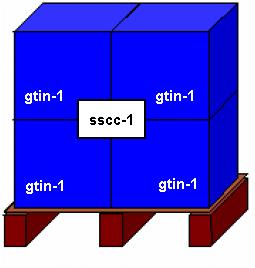
DESADV message example:
... . CPS+1' First (highest) consignment level PAC+1++PX' Current consignment level [shipment] consists of 1 pallet CPS+2+1' Second CPS; parent = shipment PAC+1++PX' Current consignment level [outer packaging] consists of 1 pallet PCI+33E' Packaging marked with SSCC GIN+BJ+<SSCC-1>' Packaging [pallet] identified by SSCC <SSCC-1> CPS+3+2' Third CPS; parent = CPS+2 [pallet] PAC+4++PK' Current consignment level consists of 4 packages LIN+1++<GTIN-1>:SRV' Current (first) line item is identified by GTIN <GTIN-1> QTY+12:4' Despatch quantity = 4 [packages] ... .
Note:
This is the only type of packaging where it is recommended to group all GTINs under the same LIN occurrence. This is possible because the cases are not individually identified by an SSCC, which makes them interchangeable.
In case the pallet contains different trade items, the proposed solution is identical. The only difference is that now multiple line items are needed:
Figure: Heterogeneous content, label on pallet
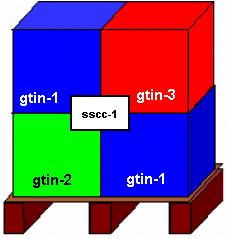
DESADV message example:
... . CPS+1' First (highest) consignment level PAC+1++PX' Current consignment level [shipment] consists of 1 pallet CPS+2+1' Second CPS; parent = shipment PAC+1++PX' Current consignment level [outer packaging] consists of 1 pallet PCI+33E' Packaging marked with SSCC GIN+BJ+<SSCC-1>' Packaging [pallet] identified by SSCC <SSCC-1> CPS+3+2' Third CPS; parent = CPS+2 [pallet] PAC+4++PK' Current consignment level consists of 4 packages LIN+1++<GTIN-1>:SRV' Current (first) line item [standard package] is identified by GTIN <GTIN-1> QTY+12:2' Despatch quantity = 2 [packages] LIN+2++<GTIN-2>:SRV' Current (second) line item [standard package] is identified by GTIN <GTIN-2> QTY+12:1' Despatch quantity = 1 [package] LIN+3++<GTIN-3>:SRV' Current (third) line item [standard package] is identified by GTIN <GTIN-3> QTY+12:1' Despatch quantity = 1 [package] ... .
In this packaging structure not only the logistic units carry an SSCC, but also the items at the next lower hierarchical level (= Content level).
Every SSCC corresponds to a CPS occurrence.
This situation corresponds to Option 4 of the “full” EANCOM® DESADV message.
Figure: Homogeneous content, labels on pallet and cases
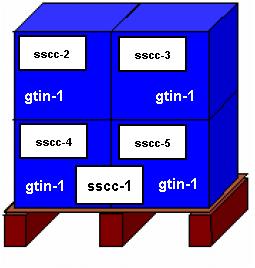
Figure: Heterogeneous content, labels on pallet and cases
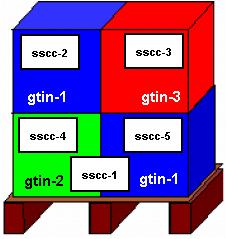
DESADV message example for heterogeneous content (labels on pallet and cases)
... . CPS+1' First (highest) consignment level PAC+1++PX' Current consignment level [shipment] consists of 1 pallet CPS+2+1' Second CPS; parent = shipment PAC+1++PX' Current consignment level [outer packaging] consists of 1 pallet PCI+33E' Packaging marked with SSCC GIN+BJ+<SSCC-1>' Packaging [pallet] identified by SSCC <SSCC-1> CPS+3+2' Third CPS; parent = CPS+2 [pallet] PAC+1++CT' Current consignment level consists of 1 carton PCI+33E' Packaging marked with SSCC GIN+BJ+<SSCC-2>' Packaging [carton] identified by SSCC <SSCC-2> LIN+1++<GTIN-1>:SRV' Current (first) line item [standard package] is identified by GTIN <GTIN-1> QTY+12:1' Despatch quantity = 1 [carton] CPS+4+2' Fourth CPS; parent = CPS+2 [pallet] PAC+1++CT' Current consignment level consists of 1 carton PCI+33E' Packaging marked with SSCC GIN+BJ+<SSCC-3>' Packaging [carton] identified by SSCC <SSCC-3> LIN+2++<GTIN-3>:SRV' Current (second) line item [standard package] is identified by GTIN <GTIN-3> QTY+12:1' Despatch quantity = 1 [package] CPS+5+2' Fifth CPS; parent = CPS+2 [pallet] PAC+1++CT' Current consignment level consists of 1 carton PCI+33E' Packaging marked with SSCC GIN+BJ+<SSCC-4>' Packaging [carton] identified by SSCC <SSCC-4> LIN+3++<GTIN-2>:SRV' Current (third) line item [standard package] is identified by GTIN <GTIN-2> QTY+12:1' Despatch quantity = 1 [package] CPS+6+2' Sixth CPS; parent = CPS+2 [pallet] PAC+1++CT' Current consignment level consists of 1 carton PCI+33E' Packaging marked with SSCC GIN+BJ+<SSCC-5>' Packaging [carton] identified by SSCC <SSCC-5> LIN+4++<GTIN-1>:SRV' Current (third) line item [standard package] is identified by GTIN <GTIN-1> QTY+12:1' Despatch quantity = 1 [package] ... .
Note:
For the homogeneous example replace all GTINs with <GTIN-1> in the message above.
For this packaging structure the logistic units do not carry an SSCC; only the items at the next lower hierarchical level (= Content level) do.
Again, every SSCC corresponds to a CPS occurrence.
Important:
This situation doesn’t correspond to any of the 4 Options of the “full” EANCOM® DESADV message. However, as it is a simplified variant of Option 4, it is fully in line with that Option (as compared to this situation, only the PCI-GIN segments at CPS+2 level are missing — also see previous section).
Figure: Homogeneous content, label on cases
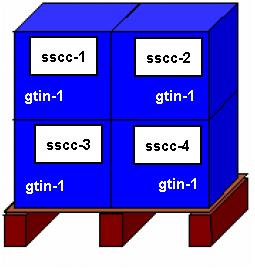
Figure: Heterogeneous content, label on cases
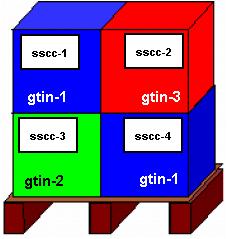
DESADV message example for heterogeneous content (labels only on cases)
... . CPS+1' First (highest) consignment level PAC+1++PX' Current consignment level [shipment] consists of 1 pallet CPS+2+1' Second CPS; parent = shipment PAC++PX' Current consignment level [outer packaging] consists of 1 pallet CPS+3+2' Third CPS; parent = CPS+2 [pallet] PAC+1++CT' Current consignment level consists of 1 carton PCI+33E' Packaging [carton] marked with SSCC GIN+BJ+<SSCC-1>' Packaging [carton] identified by SSCC <SSCC-1> LIN+1++<GTIN-1>:SRV' Current (first) line item [standard package] is identified by GTIN <GTIN-1> QTY+12:1' Despatch quantity = 1 [carton] CPS+4+2' Fourth CPS; parent = CPS+2 [pallet] PAC+1++CT' Current consignment level consists of 1 carton PCI+33E' Packaging marked with SSCC GIN+BJ+<SSCC-2>' Packaging [carton] identified by SSCC <SSCC-2> LIN+2++<GTIN-3>:SRV' Current (second) line item [standard package] is identified by GTIN <GTIN-3> QTY+12:1' Despatch quantity = 1 [carton] CPS+5+2' Fifth CPS; parent = CPS+2 [pallet] PAC+1++CT' Current consignment level consists of 1 carton PCI+33E' Packaging marked with SSCC GIN+BJ+<SSCC-3>' Packaging [carton] identified by SSCC <SSCC-3> LIN+3++<GTIN-2>:SRV' Current (third) line item [standard package] is identified by GTIN <GTIN-2> QTY+12:1' Despatch quantity = 1 [carton] CPS+6+2' Sixth CPS; parent = CPS+2 [pallet] PAC+1++CT' Current consignment level consists of 1 carton PCI+33E' Packaging marked with SSCC GIN+BJ+<SSCC-4>' Packaging [carton] identified by SSCC <SSCC-4> LIN+4++<GTIN-1>:SRV' Current (third) line item [standard package] is identified by GTIN <GTIN-1> QTY+12:1' Despatch quantity = 1 [carton] ... .
Note:
For the homogeneous example replace all GTINs with <GTIN-1> in the message above.
It is worth noting that the only difference with the scenario of the previous section resides in the absence of the PCI-GIN segments at CPS+2.
A sandwich pallet is a stack of two or more pallets (roughly of the same size), sealed or otherwise tied together for transport reasons. After their unloading the pallets are handled separately.
Note:
In EANCOM® no code value is available to explicitly describe a pallet as a sandwich pallet.
As no single code is yet available to express that a pallet is a sandwich pallet, a combination of three codes should be used to unambiguously describe the stacking together of the composing pallets. This effect is reached by combining a PAC segment, DE 7065 = ‘X11’ (= Bandaged package (GS1 Code)), a MEA segment, DE 6411 = ‘PF’ (= Pallet (lift)) and a MEA segment DE 6313 = ‘LAY’ (Number of layers (GS1 Code)) in conjunction with DE 6314 (actual number of layers).
Next, the composing pallets have to be described. In practice, these will be of the “Logistic Unit with SSCC at Logistic Unit level” type (see 4.3.1.), for they are regarded as already the second hierarchical level (hence content level) with an SSCC. Further SSCCs, i.e. at case level, are possible, but are not taken into consideration in this document.
Note:
Often loose pallets are stacked on top of each other without any sealing or other way to connect them. In that case the stacked pallets should be treated as separate pallets in the DESADV, since there is no guarantee that these pallets will be loaded and unloaded together.
Figure: Homogeneous content, sandwich pallet
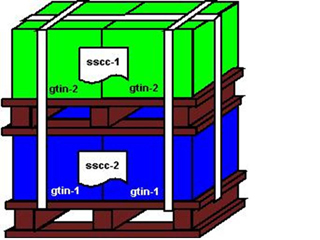
Figure: Homogeneous content, sandwich pallet, with "master" label
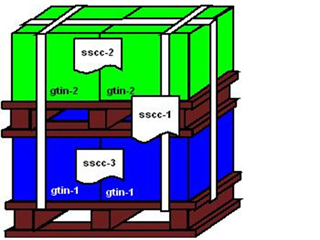
DESADV message example for homogeneous content, sandwich pallet, with "master" label
... . CPS+1' First (highest) consignment level PAC+1++X11::9' Current consignment level [shipment] consists of 1 bandaged package CPS+2+1' Second CPS; parent = shipment PAC++PX' Current consignment level [outer packaging] consists of 1 pallet MEA+PD++PF:2' Physical dimensions of current packaging: 2 [stacked] pallets MEA+PD+LAY+PCE:2' The (sandwich) pallet has 2 layers. PCI+33E' Packaging [carton] marked with SSCC GIN+BJ+<SSCC-1>' Packaging [carton] identified by SSCC <SSCC-1> CPS+3+2' Third CPS; parent = CPS+2 [bandaged pallet] PAC+2++CT' Current consignment level consists of 2 cartons LIN+1++<GTIN-2>:SRV' Current (first) line item [standard carton] is identified by GTIN <GTIN-2> QTY+12:2' Despatch quantity = 2 [cartons] CPS+4+3' Fourth CPS; parent = CPS+3 [upper pallet] PAC+1++PX' Current consignment level consists of 1 pallet PCI+33E' Packaging marked with SSCC GIN+BJ+<SSCC-2>' Packaging [lower pallet] identified by SSCC <SSCC-2> CPS+5+2' Fifth CPS; parent = CPS+2 [bandaged pallet] PAC+2++CT' Current consignment level consists of 2 cartons LIN+2++<GTIN-1>:SRV' Current (second) line item [standard package] is identified by GTIN <GTIN-1> QTY+12:2' Despatch quantity = 2 [cartons] ... .
Note:
As the pallets composing the sandwich pallet must be regarded as equal (and thus interchangeable), no specific order for their description can be defined. This can be done top-down or bottum-up, without any preference for either approach.
Figure: Heterogeneous content, sandwich pallet
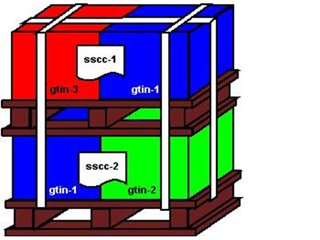
Figure: Heterogeneous content, sandwich pallet with "master" label
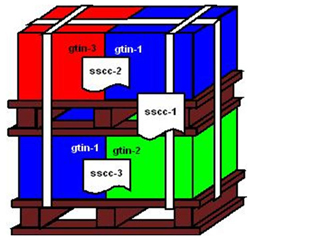
DESADV message example for heterogenous content, sandwich pallet, with "master" label
... . CPS+1' First (highest) consignment level PAC+1++X11::9' Current consignment level [shipment] consists of 1 bandaged package CPS+2+1' Second CPS; parent = shipment PAC+1++X11::9' Current consignment level [shipment] consists of 1 bandaged package MEA+PD++PF:2' Physical dimensions of current packaging: 2 [stacked] pallets MEA+PD+LAY+PCE:2' The (sandwich) pallet has 2 layers. PCI+33E' Packaging marked with SSCC GIN+BJ+<SSCC-1>' Packaging [bandaged package] identified by SSCC <SSCC-1> CPS+3+2' Third CPS; parent = CPS+2 [bandaged pallet] PAC+1++PX' Current consignment level consists of 1 pallet PCI+33E' Packaging marked with SSCC GIN+BJ+<SSCC-2>' Packaging [upper pallet] identified by SSCC <SSCC-2> CPS+4+3' Fourth CPS; parent = CPS+3 [upper pallet] PAC+2++CT' Current consignment level consists of 2 cartons LIN+1++<GTIN-3>:SRV' Current (first) line item [standard carton] is identified by GTIN <GTIN-3> QTY+12:1' Despatch quantity = 1 [carton] LIN+2++<GTIN-1>:SRV' Current (second) line item [standard package] is identified by GTIN <GTIN-1> QTY+12:1' Despatch quantity = 1 [carton] CPS+5+2' Fifth CPS; parent = CPS+2 [bandaged pallet] PAC+1++PX' Current consignment level consists of 1 pallet PCI+33E' Packaging marked with SSCC GIN+BJ+<SSCC-3>' Packaging [lower pallet] identified by SSCC <SSCC-3> CPS+6+5' Sixth CPS; parent = CPS+5 [lower pallet] PAC+2++CT' Current consignment level consists of 2 cartons LIN+3++<GTIN-1>:SRV' Current (third) line item [standard package] is identified by GTIN <GTIN-1> QTY+12:1' Despatch quantity = 1 [carton] LIN+4++<GTIN-2>:SRV' Current (third) line item [standard package] is identified by GTIN <GTIN-2> QTY+12:1' Despatch quantity = 1 [carton] ... .
Note:
As the the pallets composing the sandwich pallet must be regarded as equal (and thus interchangeable), no specific order for their description can be defined. This can be done top-down or bottum-up, without any preference for either approach.
This situation applies to all trade items that are shipped as separate units, such as rolls of carpet, racks, etc.
Typical for this packaging structure is that the shipment lacks in fact all structure.
All units are logistic units and have an SSCC.
This situation corresponds to Option 3 of the “full” EANCOM® DESADV message.
Note:
It must be catered for that the items on a rack cannot leave the rack (e.g. accidentally fall off), for otherwise the link between SSCC and GTIN will be lost. This can e.g. be achieved with a plastic cover.
The rack is particular in this example, for it is NOT a standard article and hence the rack with its content do NOT correspond with a GTIN! (the rack could just as well be a box marked with an SSCC and containing some smaller GTINs)
Figure: Separate items
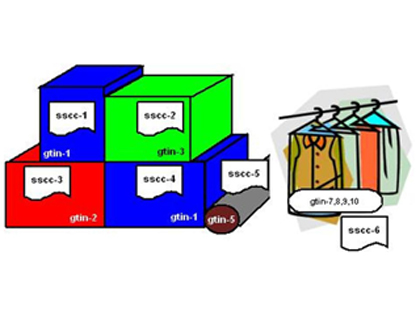
DESADV message example for separate products
... . CPS+1' First ("dummy") CPS PAC+4++CT' Current consignment level [shipment] consists of 4 cartons PAC+1++RO' Current consignment level [shipment] consists of 1 roll [carpet] PAC+1++RJ' Current consignment level [shipment] consists of 1 rack CPS+2+1' Second CPS; parent = shipment PAC+1++CT' Current consignment level consists of 1 carton PCI+33E' Packaging marked with SSCC GIN+BJ+<SSCC-1>' Packaging [carton] identified by SSCC <SSCC-1> LIN+1++<GTIN-1>:SRV' Current (first) line item [standard carton] is identified by GTIN <GTIN-1> QTY+12:1' Despatch quantity = 1 [carton] CPS+3+1' Third CPS; parent = shipment PAC+1++CT' Current consignment level consists of 1 carton PCI+33E' Packaging marked with SSCC GIN+BJ+<SSCC-2>' Packaging [carton] identified by SSCC <SSCC-2> LIN+2++<GTIN-3>:SRV' Current (second) line item [standard carton] is identified by GTIN <GTIN-3> QTY+12:1' Despatch quantity = 1 [carton] CPS+4+1' Fourth CPS; parent = CPS+1 [upper pallet] PAC+1++CT' Current consignment level consists of 1 carton PCI+33E' Packaging marked with SSCC GIN+BJ+<SSCC-3>' Packaging [carton] identified by SSCC <SSCC-3> LIN+3++<GTIN-2>:SRV' Current (third) line item [standard carton] is identified by GTIN <GTIN-2> QTY+12:1' Despatch quantity = 1 [carton] CPS+5+1' Fifth CPS; parent = CPS+1 [upper pallet] PAC+1++CT' Current consignment level consists of 1 carton PCI+33E' Packaging marked with SSCC GIN+BJ+<SSCC-4>' Packaging [carton] identified by SSCC <SSCC-4> LIN+4++<GTIN-1>:SRV' Current (fourth) line item [standard carton] is identified by GTIN <GTIN-1> QTY+12:1' Despatch quantity = 1 [carton] CPS+6+1' Sixth CPS; parent = CPS+1 PAC+1++RO' Current consignment level consists of 1 roll [carpet] PCI+33E' Packaging marked with SSCC GIN+BJ+<SSCC-5>' Packaging [roll] identified by SSCC <SSCC-5> LIN+5++<GTIN-5>:SRV' Current (fifth) line item [roll] is identified by GTIN <GTIN-5> QTY+12:1' Despatch quantity = 1 [roll] CPS+7+1' Seventh CPS; parent = CPS+1 PAC+1++RJ' Current consignment level consists of 1 rack PCI+33E' Packaging marked with SSCC GIN+BJ+<SSCC-6>' Packaging [rack] identified by SSCC <SSCC-6> LIN+6++<GTIN-7>:SRV' Current (sixth) line item [vest] is identified by GTIN <GTIN-7> QTY+12:1' Despatch quantity = 1 [vest on rack] LIN+7++<GTIN-8>:SRV' Current (seventh) line item [trousers] is identified by GTIN <GTIN-8> QTY+12:1' Despatch quantity = 1 [trousers on rack] LIN+8++<GTIN-9>:SRV' Current (eighth) line item [trousers] is identified by GTIN <GTIN-9> QTY+12:1' Despatch quantity = 1 [trousers on rack] LIN+9++<GTIN-10>:SRV' Current (ninth) line item [trousers] is identified by GTIN <GTIN-10> QTY+12:1' Despatch quantity = 1 [trousers on rack] ... .
This appendix provides a solution which is compliant with the “full” EANCOM® DESADV message for three of the Packaging Structures of section 4.3.
The difference between both approaches is that per the Options as defined in the full” EANCOM® 2002 DESADV message (see 4.) only a hierarchical level of the shipment can correspond to a CPS segment (as opposed to every single SSCC). Please refer to the corresponding sections for more context.
Please refer to section 4.3.2. for further details about this packaging structure.
Figure: Heterogeneous content, labels on pallet and cases

Example for heterogeneous content (labels on pallet and cases)
... . CPS+1' First (highest) consignment level PAC+1++PX' Current consignment level [shipment] consists of 1 pallet CPS+2+1' Second CPS; parent = shipment PAC+1++PX' Current consignment level [outer packaging] consists of 1 pallet PCI+33E' Packaging marked with SSCC GIN+BJ+<SSCC-1>' Packaging [pallet] identified by SSCC <SSCC-1> CPS+3+2' Third CPS; parent = CPS+2 [pallet] PAC+4++CT' Current consignment level consists of 4 cartons LIN+1++<GTIN-1>:SRV' Current (first) line item [standard package] is identified by GTIN <GTIN-1> QTY+12:1' Despatch quantity = 1 [carton] PCI+33E' Packaging marked with SSCC GIN+BJ+<SSCC-2>' Packaging [carton] identified by SSCC <SSCC-2> LIN+2++<GTIN-3>:SRV' Current (second) line item [standard carton] is identified by GTIN <GTIN-3> QTY+12:1' Despatch quantity = 1 [carton] PCI+33E' Packaging marked with SSCC GIN+BJ+<SSCC-5>' Packaging [carton] identified by SSCC <SSCC-5> LIN+3++<GTIN-2>:SRV' Current (third) line item [standard carton] is identified by GTIN <GTIN-2> QTY+12:1' Despatch quantity = 1 [carton] PCI+33E' Packaging marked with SSCC GIN+BJ+<SSCC-3>' Packaging [carton] identified by SSCC <SSCC-3> LIN+4++<GTIN-1>:SRV' Current (third) line item [standard carton] is identified by GTIN <GTIN-1> QTY+12:1' Despatch quantity = 1 [carton] PCI+33E' Packaging marked with SSCC GIN+BJ+<SSCC-4>' Packaging [carton] identified by SSCC <SSCC-4> ... .
Note:
The solution for the homogeneous example (in which all GTINs are replaced with <GTIN-1>) is identical up to LIN+1 and from there on looks as follows:
... . LIN+1++<GTIN-1>:SRV' Current (first) line item [standard package] is identified by GTIN <GTIN-1> QTY+12:4' Despatch quantity = 4 [cartons] PCI+33E' Packaging marked with SSCC GIN+BJ+<SSCC-2>+<SSCC-3>+<SSCC-4>+<SSCC-5>' Packaging [carton] identified by SSCC <SSCC-2>, <SSCC-3>, <SSCC-4> and <SSCC-5> ... .
Please refer to section 4.3.3. for further details about this packaging structure.
Figure: Heterogeneous content, labels on cases

Example for heterogeneous content (labels only on cases)
... . CPS+1' First (highest) consignment level PAC+1++PX' Current consignment level [shipment] consists of 1 pallet CPS+2+1' Second CPS; parent = shipment PAC+1++PX' Current consignment level [outer packaging] consists of 1 pallet CPS+3+2' Third CPS; parent = CPS+2 [pallet] PAC+4++CT' Current consignment level consists of 4 cartons LIN+1++<GTIN-1>:SRV' Current (first) line item [standard package] is identified by GTIN <GTIN-1> QTY+12:1' Despatch quantity = 1 [carton] PCI+33E' Packaging marked with SSCC GIN+BJ+<SSCC-2>' Packaging [carton] identified by SSCC <SSCC-2> LIN+2++<GTIN-3>:SRV' Current (second) line item [standard carton] is identified by GTIN <GTIN-3> QTY+12:1' Despatch quantity = 1 [carton] PCI+33E' Packaging marked with SSCC GIN+BJ+<SSCC-4>' Packaging [carton] identified by SSCC <SSCC-4> LIN+3++<GTIN-2>:SRV' Current (third) line item [standard carton] is identified by GTIN <GTIN-2> QTY+12:1' Despatch quantity = 1 [carton] PCI+33E' Packaging marked with SSCC GIN+BJ+<SSCC-2>' Packaging [carton] identified by SSCC <SSCC-2> LIN+4++<GTIN-1>:SRV' Current (fourth) line item [standard carton] is identified by GTIN <GTIN-1> QTY+12:1' Despatch quantity = 1 [carton] PCI+33E' Packaging marked with SSCC GIN+BJ+<SSCC-3>' Packaging [carton] identified by SSCC <SSCC-3> ... .
Note:
It is worth noting that the only difference with the scenario of the previous section resides in the absence of the PCI-GIN segments at CPS+2.
For the solution for the homogeneous example (in which all GTINs are replaced with <GTIN 1>) it suffices to check the homogeneous case of the previous section, as both examples are identical from LIN+1 on.
Please refer to section 4.3.5. for further details about this packaging structure.
All units are logistic units and have an SSCC.
Figure: Separate items

DESADV message example for separate items (combination of standardized and non-standardized packagings)
... . CPS+1' First ("dummy") CPS PAC+4++CT' Current consignment level [shipment] consists of 4 cartons PAC+1++RO' Current consignment level [shipment] consists of 1 roll [carpet] PAC+1++RJ' Current consignment level [shipment] consists of 1 rack CPS+2+1' Second CPS; parent = shipment PAC+2++CT' Current consignment level consists of 2 cartons PCI+33E' Packaging marked with SSCC GIN+BJ+<SSCC-1>+<SSCC-4>' Packaging [carton] identified by SSCC <SSCC-1> and <SSCC-4> LIN+1++<GTIN-1>:SRV' Current (first) line item [standard carton] is identified by GTIN <GTIN-1> QTY+12:2' Despatch quantity = 2 [cartons] CPS+3+1' Third CPS; parent = shipment PAC+1++CT' Current consignment level consists of 1 carton PCI+33E' Packaging marked with SSCC GIN+BJ+<SSCC-2>' Packaging [carton] identified by SSCC <SSCC-2> LIN+2++<GTIN-3>:SRV' Current (second) line item [standard carton] is identified by GTIN <GTIN-3> QTY+12:1' Despatch quantity = 1 [carton] CPS+4+1' Fourth CPS; parent = shipment PAC+1++CT' Current consignment level consists of 1 carton PCI+33E' Packaging marked with SSCC GIN+BJ+<SSCC-3>' Packaging [carton] identified by SSCC <SSCC-3> LIN+3++<GTIN-2>:SRV' Current (third) line item [standard carton] is identified by GTIN <GTIN-2> QTY+12:1' Despatch quantity = 1 [carton] CPS+5+1' Fifth CPS; parent = CPS+1 [upper pallet] PAC+1++RO' Current consignment level consists of 1 roll [carpet] PCI+33E' Packaging marked with SSCC GIN+BJ+<SSCC-5>' Packaging [roll] identified by SSCC <SSCC-5> LIN+4++<GTIN-5>:SRV' Current (fourth) line item [standard carton] is identified by GTIN <GTIN-5> QTY+12:1' Despatch quantity = 1 [carton] CPS+6+1' Sixth CPS; parent = shipment PAC+1++RJ' Current consignment level consists of 1 rack PCI+33E' Packaging marked with SSCC GIN+BJ+<SSCC-6>' Packaging [rack] identified by SSCC <SSCC-6> LIN+5++<GTIN-7>:SRV' Current (fifth) line item [standard vest] is identified by GTIN <GTIN-7> QTY+12:1' Despatch quantity = 1 [vest on rack] LIN+6++<GTIN-8>:SRV' Current (sixth) line item [vest] is identified by GTIN <GTIN-8> QTY+12:1' Despatch quantity = 1 [trousers on rack] LIN+7++<GTIN-9>:SRV' Current (seventh) line item [standard trousers] is identified by GTIN <GTIN-9> QTY+12:1' Despatch quantity = 1 [trousers on rack] LIN+8++<GTIN-10>:SRV' Current (eighth) line item [trousers] is identified by GTIN <GTIN-10> QTY+12:1' Despatch quantity = 1 [trousers on rack] ... .
Note:
If this example consisted of standardized packagings only, instead of the above mixture, it could also be regarded as an Option 2. When leaving out the rack in the figure above, that would give the following solution:
Example for separate items (standardized packagings only)
... . CPS+1' First ("dummy") CPS PAC+5' Shipment consists of 5 items CPS+2+1' Second CPS; parent = shipment LIN+1++<GTIN-1>:SRV' Current (first) line item [standard carton] is identified by GTIN <GTIN-1> QTY+12:2' Despatch quantity = 2 [cartons] PCI+33E' Packaging marked with SSCC GIN+BJ+<SSCC-1>+<SSCC-4>' Packaging [cartons] identified by SSCC <SSCC-1> and <SSCC-4> LIN+2++<GTIN-2>:SRV' Current (second) line item [standard carton] is identified by GTIN <GTIN-2> QTY+12:1' Despatch quantity = 1 [carton] PCI+33E' Packaging marked with SSCC GIN+BJ+<SSCC-3>' Packaging [carton] identified by SSCC <SSCC-3> LIN+3++<GTIN-3>:SRV' Current (third) line item [standard carton] is identified by GTIN <GTIN-3> QTY+12:1' Despatch quantity = 1 [carton] PCI+33E' Packaging marked with SSCC GIN+BJ+<SSCC-2>' Packaging [carton] identified by SSCC <SSCC-2> LIN+4++<GTIN-5>:SRV' Current (fourth) line item [standard carton] is identified by GTIN <GTIN-5> QTY+12:1' Despatch quantity = 1 [carton] PCI+33E' Packaging marked with SSCC GIN+BJ+<SSCC-5>' Packaging [roll] identified by SSCC <SSCC-5> ... .
| <<< back | top ^ |
| © GS1 in Europe |